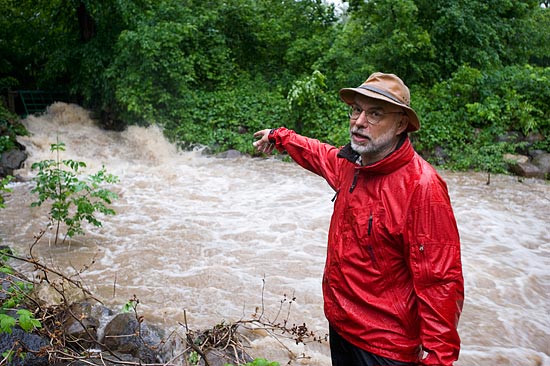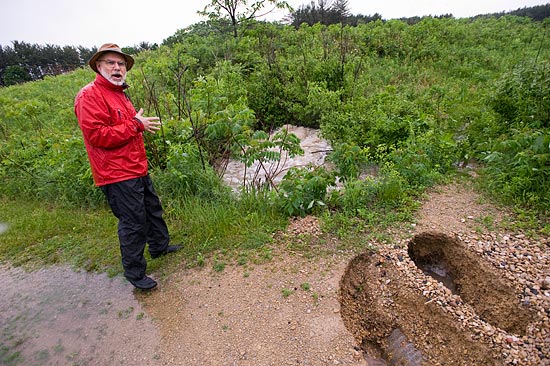New projects take aim at Arboretum stormwater problems
Even after the most violent rains, stormwater usually recedes from city streets within hours. But in the downstream places where this water collects, the impact can be lasting, and nowhere is this more apparent than in the UW Arboretum.
Almost a half billion gallons of urban runoff gushes into this renowned collection of restored ecological communities each year, bringing with it a host of problems. Nearly every stormwater pond, ditch and flume on Arboretum property has failed. A delta of eroded sediment is spreading its muddy fingers across Lake Wingra’s western end. And large swaths of the Curtis and Greene prairies — among the oldest and finest restored prairies in the world — have succumbed to a runoff-loving invasive grass.
Situated downhill from nearly everyplace else in its urban surroundings, the Arboretum is unlikely to see less runoff anytime soon. However, the incoming water can be handled more effectively, which is exactly the goal of a new set of stormwater management facilities the Arboretum is starting to build this summer, in cooperation with the cities of Madison and Fitchburg, the Town of Madison and the Wisconsin Department of Transportation (DOT).
“I think this partnership is important. We all recognize there’s a problem, and we’re all seeking solutions to fix it,” says Arboretum director Kevin McSweeney. “It’s not that the Arboretum expects to stop getting water from the outside, but we want to be able to manage what comes to us in a much more controlled way.”
The Arboretum invites the public to learn more about the projects at an open house from 7-9 p.m. on Monday, Sept. 8, at the McKay Visitor Center, 1207 Seminole Highway.
Traveling underground in pipes from places as near as the Vilas neighborhood and as far away as Research Park and Orchard Ridge, stormwater has for decades discharged into the Arboretum and then wended its way into Lake Wingra and Wingra Creek. But as urban development in the watershed has risen, so has the amount of runoff coursing across the property, causing widespread erosion, degrading wetlands, and carrying in sand and pollutants from city streets.
The projects now launching to address these problems were developed by a group called the Arboretum stormwater committee, with extensive help from UW–Madison researchers across campus, as well as city engineers and private consultants. Fixing or replacing the Arboretum’s existing stormwater ponds and channels is the primary aim. But each project will also serve the Arboretum’s core missions of education and research, says committee chair David S. Liebl.
“The Arboretum is very cognizant that it has a limited parcel of property with a unique research and teaching mission, which means there’s a reluctance to trade land for detention ponds if that’s all they’re going to be,” says Liebl, who has appointments in the UW–Madison College of Engineering and UW-Extension. “So we’ve tried to meld those missions with what would be considered contemporary stormwater management construction.”
For example, a project beginning this winter along Manitou Way in the Nakoma neighborhood will include a wet detention pond designed to slow stormwater flow and let sediments settle. But it will also feature a shallow, 100-foot-wide swale where scientists will test how an assortment of native plants do at stabilizing soils, controlling erosion and removing nutrients — all of which are vital to the water quality of Lake Wingra.
“These are all great questions that need to be asked because urban runoff is becoming more and more of an issue around the country,” says Gary Brown, who oversees Arboretum projects for UW–Madison’s Division of Facilities Planning and Management. “So the research that the Arboretum does in conjunction with these projects is going to be used quite widely, I’m sure.”
Brown notes that the new facilities are being paid for through a combination of university, city and DOT funds, with UW–Madison contributing extra money in some cases to support a research component.
Seven projects are currently planned, and Liebl estimates the entire endeavor will take about five years to complete. Yet this is just the beginning, he adds. To truly solve the Arboretum’s runoff woes, homeowners and businesses will also need to pitch in — for example, by building vegetated plots, called rain gardens, which capture runoff and let it infiltrate the soil.
“After the existing problems are fixed, the question is what can we do in the surrounding watershed and community to reduce the impact of stormwater?” says Liebl. “Because in 15 or 20 years when these stormwater facilities need to be rehabilitated again, we want to be looking not at a worse situation than we have now, but a better one.”
The first two projects are:
Johannsen Pond (late summer 2008): Urban runoff from the Arbor Hills neighborhood, South Beltline Highway and Todd Drive commercial area is conveyed to the Arboretum’s Johannsen Pond via a concrete flume and storm drains. Originally built for erosion control, the pond lacks the capacity to remove nutrients and sediments before they enter the downstream Teal Pond wetlands and Lake Wingra.
The rehabilitation plan for Johannsen Pond will both protect the Arboretum and foster research and teaching. A special fore-bay will be added to trap and clean spills of petroleum or other chemicals, while an adjoining industrial site will pre-treat runoff to remove oils and grease before discharging to the pond. In addition, the Arboretum will build a stormwater management research facility (SMRF) upstream from the pond. The SMRF will direct flows into a broad, shallow basin, where native plant will be tested for their ability to remove nutrients and infiltrate groundwater.
Manitou Way/Secret Pond (winter 2008): Stormwater runoff draining through the Manitou Way outfall from the surrounding Nakoma neighborhood combines with runoff from the Odana Road and Whitney Way areas to make up about 40 percent of all runoff entering the Arboretum. A trench currently conveys this stormwater through the basin of (now failed) Secret Pond and West Wingra Marsh before the runoff enters Lake Wingra. Large amounts of sediment come into the lake at this site, and the stormwater’s elevated temperatures and nutrients have helped invasive species to spread.
To remediate this situation, a 1.4-acre wet detention pond will be built at the outfall adjoining Manitou Way, where it will collect 60 percent of sediments and debris, and moderate flows downstream. The trench will be replaced with a broad swale that UW–Madison faculty and students will use to investigate the ability of various native plant species to stabilize soils and reduce erosion.
Enjoy this story?
Read more news from the College of EngineeringTags: arboretum, audio, College of Engineering, research



